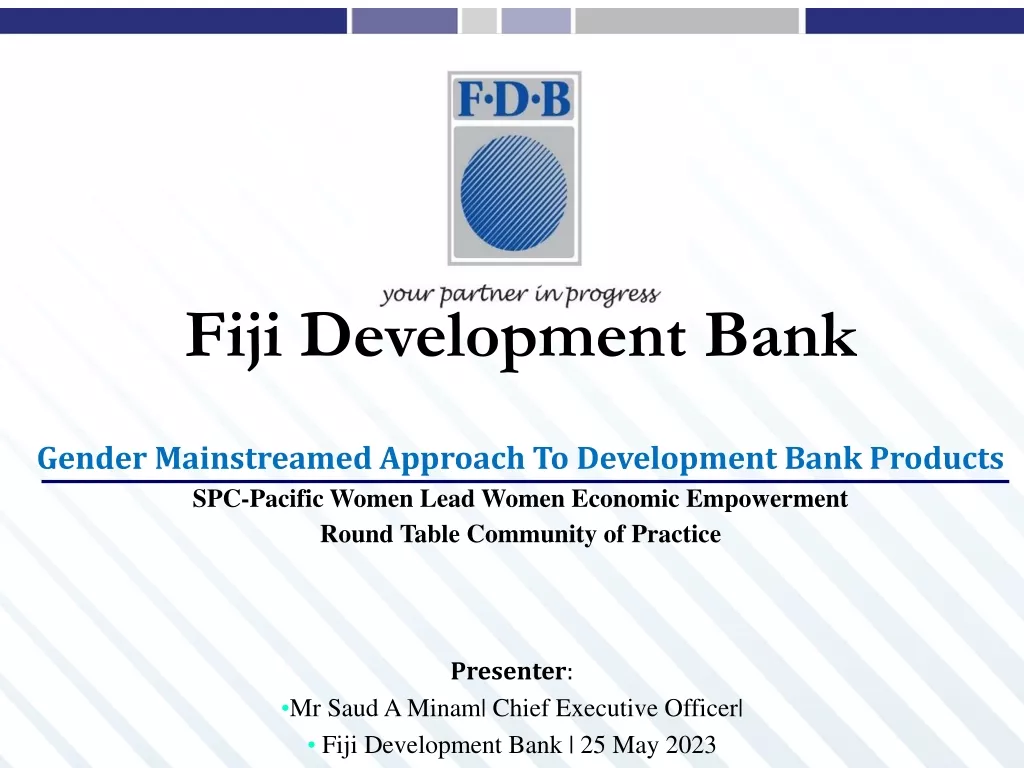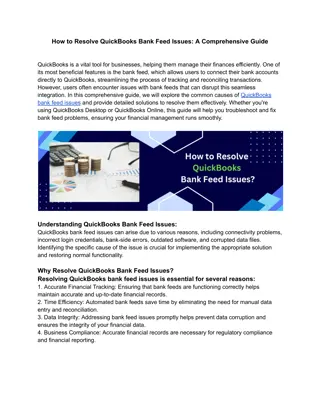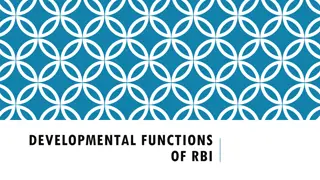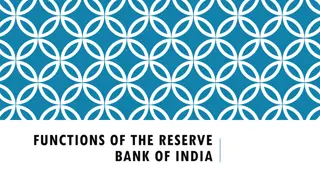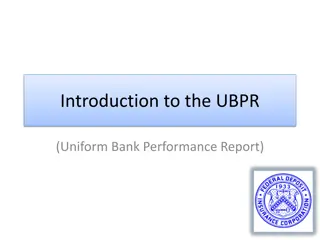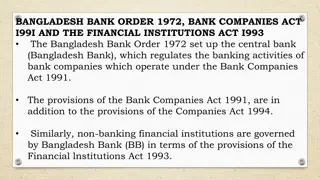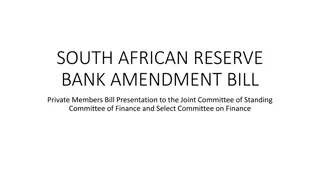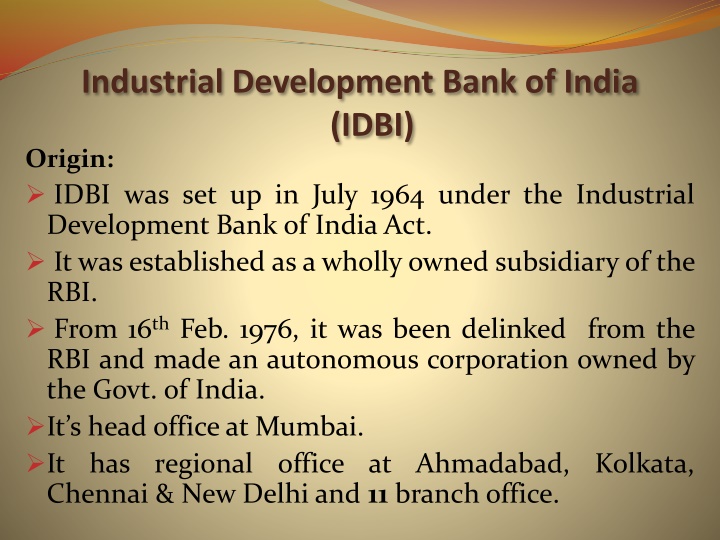
Industrial Development Bank of India (IDBI)
IDBI, established in 1964, plays a crucial role in the capital market by focusing on primary market activities. With a strong capital base and diverse funding sources, IDBI offers financing for industrial projects and supports entrepreneurship development. Learn more about IDBI's milestones, functions, and services.
Download Presentation

Please find below an Image/Link to download the presentation.
The content on the website is provided AS IS for your information and personal use only. It may not be sold, licensed, or shared on other websites without obtaining consent from the author. If you encounter any issues during the download, it is possible that the publisher has removed the file from their server.
You are allowed to download the files provided on this website for personal or commercial use, subject to the condition that they are used lawfully. All files are the property of their respective owners.
The content on the website is provided AS IS for your information and personal use only. It may not be sold, licensed, or shared on other websites without obtaining consent from the author.
E N D
Presentation Transcript
Industrial Development Bank of India (IDBI) Origin: IDBI was set up in July 1964 under the Industrial Development Bank of India Act. It was established as a wholly owned subsidiary of the RBI. From 16thFeb. 1976, it was been delinked from the RBI and made an autonomous corporation owned by the Govt. of India. It s head officeat Mumbai. It has regional office at Ahmadabad, Kolkata, Chennai & New Delhi and 11 branch office.
Role in Capital Market IDBI plays an important role in the capital market It plays more in the primary market than in the secondary market it does not aim at speculative profits It subscribes to new issues of shares, debentures and bonds. Mutual fund plays well in the secondary market also IDBI has bee instrumental in establishing the process of industrial development of the country. In 2003, it entered the retail finance sector by acquiring the entire shareholding of Tata finance Ltd.
Capital and Management The paid up capital of IDBI, wholly subscribed by the Govt. stored at Rs. 753 croer as at the end of March 1995. It s administration in vested in the hands of a Board of Directors. The board consists Managing Director appointed by the central Government. A deputy governor of the RBI nominated by it and 20 other director. of a Chairman and
Resources: The principal sources of funds of IDBI are: Share capital and reserves. Borrowing from Governmentof India and RBI. Market borrowing by way of bonds. Foreign currency borrowings from World Bank, Asian Development Bank and International Markets. Deposits and other borrowings. Repayment of fast assistance by borrowers.
Milestones Functions Products and Services IDBI Provides finance for the establishment of new industrial projects as well diversification and modernization of existing industrial enterprises. IDBI undertakes / supports promotional activates including entrepreneurship development programmers for new entrepreneurs, provision of new consultancy services for small and medium enterprise. as for expansion wide ranging
IDBI offers to its borrowers the option of both fixed and variable interest rates which are based on IDBI s risk perception and credit worthiness of the borrowers. IDBI has made efforts to respond to the financial needs of the industry by constantly expanding its range of products and services.
DIRECT FINANCE The Expression Direct Finance refers to the provision of Finance to an industrial unit without the involvement of an intermediary financial institution. Equipment finance and asset credit. 2. Equipment leasing. 3. Direct discounting of bills. 4. Underwriting and direct subscription. 5. Energy conservation. 6. Venture capital 7. Working capital. 1.
INDIRECT FINANCE The expression Indirect Finance refers to the provision of finance to industrial concerns through State Financial Corporation (SFC s). State Industrial Development Corporation (SIDC s) and banks. Indirect Finance, the responsibility for repayment to IDBI rests with the relevant intermediary institution or bank.
INDIRECT FINANCE Refinancing of Industrial Loans. 1. 2. Bills Rediscounting. 3. Investments in Shares and Bonds of other. 4. Lines of Credit Institutions. FINANCIAL SERVICES Merchant Banking. 1. Forex Services. 2. Debenture Trusteeship. 3.
INDUSTRIAL CREDIT AND INVESTMENT CORPORATION OF INDIA (ICICI) ICICI was incorporated on January,5th1995 with its headquarters at Mumbai, for the specific purpose of assisting the industrial enterprises within the private sector. The original idea of forming the corporation sprang from the conversation between the Indian Government, World Bank and certain American financiers.
The Government of India had certain funds created out of the financial assistance which the Foreign Aid Department of the state department of U.S., had contributed in the form of materials. A suggestion was made that this fund be used to promote the corporation Itwas formed with an authorised capital of
Objectives: (i) Assisting in the creation, expansion and modernization of such enterprises. (ii)Encouraging and promoting the participation of private capital both internal and external, in such enterprises. (iii)Encouraging and promoting private ownership of industrial investments and the expansion of investment markets.
Resources: The initial resources of ICICI was Rs. 17.5 crores - Rs.12.5 crores in rupees and $ 10 million in foreign currencies, being loan from World Bank, by March, 1985, the paid up capital of the corporation amounted to Rs.45 croers. While reserves and surplus amounted to Rs.92 crores, borrowings of the corporation aggregated to Rs. 1,617 crores.
Facilities of ICICI Assistance to Industries. 2. Development of New Industries in Backward Regions. 3. Provision of Foreign Currency Loans. 4. Merchant Banking. 5. Facilities for Non-resident Indians. 6. Letter of Credit. 7. Project Promotion. 8. Leasing Operations. 9. Housing Loans. 10. Other Institutions Promoted. 1.
Organization Structure Originally , ICICI was started as a Development Financial Institution(DFI). In October 2001, the BOD of from ICICI Ltd., and the ICICI Bank Ltd approved the merger of ICICI Ltd. The merger was effected with from May 2002 and now it is referred to simply as ICICI Bank. The structure of ICICI Bank is divided into Five principal groups. (1.Retail Banking 2.Wholesale Banking 3.Project Finance and Special assets Management 4.Internetional business 5.Corporate centre. )
Recent Development The ICICI Bank is now second largest bank with total assets of about Rs.2513.89 billion. It has a network about 617 branches and extension counters and over 2200 ATMs spread over all over the country
LEASE FINANCING Meaning: Leasing may be defined as a contract between the owner of equipment and its user under which the equipment is bailed by its owner for a specific period in return for periodical return payments. The owner who delivers the equipment is called the lessor and the person to whom the equipment is delivered is called the lessee.
Essential features of leasing are as follows: It is a contract as defined in the Indian Contract Act,1872. 1. 2. It is an agreement between the owner of equipment called the lessor and the user called lessee. 3. The parties to the lease must be competent to contract. However a minor can be a lessor provided the lease is beneficial to him. 4. The goods are delivered to the lessee for a specified purpose and period.
5. The lease should return exactly the same goods after the lease period. 6. The ownership of the goods is retained by the lessor and only the possession of the goods is given to the lessee. 7. The goods are delivered to the lessee in return for a periodical rent.
PROCEDURE FOR MAKING A LEASE CONTRACT His name, address and the details of his business. 1. 2. Name and address of the guarantor, if any 3. Description of the equipment. 4. Name and address of the supplier and the price quoted by him. 5. Place of installation. 6. Duration of the lease.
TYPES OF LEASING Finance lease Operating lease Leveraged lease Sale and lease back Cross border lease International lease.
TYPES OF LEASING Finance Lease: Finance Lease is lease under which the present value of the minimum lease payments at the inception of the lease exceeds or is equal to substantially the whole of the fair value of the leased asset. Operating Lease: A lease is considered to be an operating lease if it does not secure for the recovery of his capital outlay plus a return on the funds invested during the lease period. It is a short period lease similar to renting of a machine or an auditorium for a few days, weeks or month.
Investor and Leveraged Lease: Lease can be either single investor lease or leveraged lease. In the case of single investor lease, there is only two parties to the transaction, viz. the lessor and the lessee. But in the case of leveraged lease, there are three parties to the transaction, viz. the lessor, the lender and the lessee. Under this lease the leasing company buys the asset with borrowed fuds. Sale and Lease Back: Under the scale and lease back arrangement, a company owning an asset sells it to another person and leases it back simultaneously. In this case the person having the ownership of the asset transfers it to another person who, in turn, leases it the seller and become the lessee.
Cross border lease: When the lessor and the lessee are domiciled in different countries, the lease is said to be cross border lease. The domicile of the supplier is immaterial. International Lease: In the case of international lease, the leasing company operates in different countries through its branches. A domestic lease is one where all parties to the agreement are domiciled in the same country. Where in the case of international lease, the parties to the lease are domiciled in different countries. These two leases are differentiated on the basis of risk. International lease has two additional risks, viz. country risk and currency risk.
LEASING IN INDIA Lease financing in India began in 1973 when the first leasing company as the First Leasing Company of India was set up. It emerged as an important supplementary source finance to the industries. It is a fund based / asset based financial service. The second leasing company known as 20th Century Leasing Ltd. Started operation in 1979.
There are two sources, viz, Lease Portfolio Securitisation and Variable Rate Bonds. Leasing has been proved to be a popular financing method for acquiring plant and machinery , especially , for small and medium sized enterprises. The Narasimham Committee has recognized the important and growing role of leasing and hire-purchase companies in the financial intermediation process.
FACTORING AND FORFAITING Factoring: Meaning :- Factoring is fund based financial service. A factor makes such a transaction possible. Factoring provides resources to finance receivables and facilitates their collection. Definition of Factoring: The term factoring has been defined variously in different countries. However, the study group appointed by the International Institute for Unification of Private Law, in Rome
During 1988 defined factoring as an arrangement between a factor and his client which includes at least two of the following services to be provided by the factor. Finance Maintenance of account Collection of Debts Protection against credit risk. A relationship between the financial institution or banker ( factor) and a business concern ( the supplier), selling goods or providing services to trade customers whereby the factor purchases book debts either with or without recourse to the supplier and in relationship thereto control credit extended to the customers and administers the sales ledger of the supplier.
Factoring Mechanism: Factoring business originates from credit sales. The main function of factoring services is the realization of credit sales. The factor enters into the realization of credit sales when the sale transaction in completed. Mainly three parties are involved in the factoring transactions the buyer, the seller and the factor
Steps in factoring: The buyer negotiates with the seller the terms of 1. purchasing materials and receives delivery of goods with invoice and instructions by the seller to make payment on the due date or gets an extension of time. 2. The seller sells the goods to the buyer. 3. The factor enters into an agreement with the seller for rendering factor services.
Services Rendered by the factor: (i) Administrative (ii) Collection (iii) Financing (iv) Credit control and credit protection (v) Advisory services.
Types of factoring: Full Factoring 1. 2. Recourse Factoring 3. Non recourse Factoring 4. Advance Factoring or Discount Factoring 5. Maturity Factoring 6. Disclosed and Undisclosed Factoring 7. Invoice Discounting
Factoring in India In India factoring is of recent origin. Many of the suppliers of goods and services, particularly small and medium industries, experience difficulty in collecting their books. Delay in collection often leads to liquidity problems, delayed production and supply affecting economic growth.
RBI Guidelines on Factoring: 1. For the present, banks cannot directly or departmentally undertake the business of factoring. While banks may invest in factoring companies with the prior approval of RBI, within specified limits, they cannot act as promoters of such companies. Banks are permitted to set up separate subsidiaries or invest in factoring companies jointly with other banks with the prior approval of RBI.
2. A factoring subsidiary or joint venture factoring company should not engage in financing other companies or other factoring companies. 3. Investment of a bank in the shares of factoring cannot exceed in the aggregate 10% of the paid up capital and the reserves of the bank.


